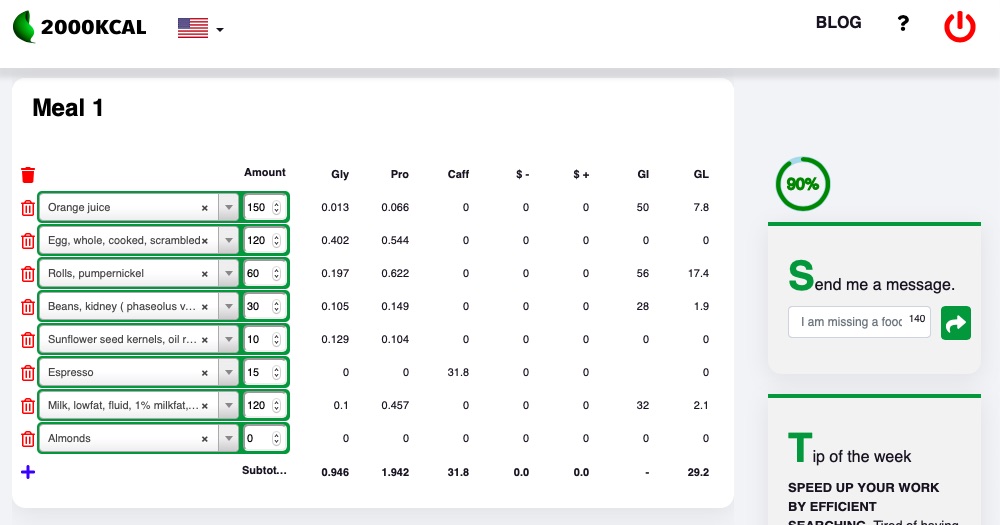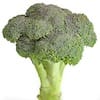Calculating the Glycemic Index & Load
(GL Calculator)
1. Glycemic Load (GL) and Glycemic Index (GI): Understanding the Importance
THE GLYCEMIC LOAD (GL) measures the impact of a particular carbohydrate food or meal on a person's blood glucose and insulin levels. The higher the GL, the greater the increase in blood glucose and corresponding insulin response. The GL is a comparative measure, meaning that the effects are measured relative to a reference food, which is typically either glucose or white bread.
The 2000KCAL Glycemic Load Calculator and the 2000KCAL web app use glucose as the reference food for calculating the GL. One unit of GL is approximately equal to the effect of consuming one gram of glucose (1 GL = 1 g glucose).
The Glycemic Load (GL) is calculated using a measure called the Glycemic Index (GI). The difference between the GL and the GI is that the GL takes into account the practical effects of consuming a particular food or meal, while the GI is a more theoretical measure.
A low glycemic diet, or a diet with a low GL, has been shown to promote human health by reducing the risk of diabetes (insulin resistance) and promoting a healthy body composition. It is recommended to keep the GL of individual meals below 25, and ideally below 20 GL units, and to maintain a total daily GL below 100. This website recommends following a low glycemic diet to support a healthy lifestyle.
IMAGE 1: Counting the GI and GL of a sample breakfast in the 2000KCAL app. As you can see in the GI column of the table, both orange juice and pumpernickel rolls have a similar GI, but the GL impact of the pumpernickel is much higher. The total GL of this breakfast is 29.2, which is on the high side. To lower the GL to under 25, we suggest omitting the orange juice or decreasing the portion size of the pumpernickel.

2. Understanding the Difference Between the Glycemic Index (GI) and the Glycemic Load (GL)
The difference between the Glycemic Index (GI) and the Glycemic Load (GL) is the difference between a theoretical measure and a practical measure. Another difference between the two is that the GI only focuses on the quality aspect of carbohydrates in a food, while the GL takes into consideration both quality as well as quantity.
The Glycemic Index. The GI ranks foods according to how their carbohydrates affect blood glucose and insulin levels. Foods with a low GI (55 or lower) have carbohydrates that are slowly digested, absorbed, and metabolized, resulting in a slower and lower rise in blood glucose and insulin. Foods with a high GI have the opposite effect. The GI is more of a theoretical concept because it assigns a value from 0 to 100 to individual foods based on the type of carbohydrates they contain, but does not take into account the amount of those carbs. As a result, two foods can have the same GI value, but have very different impacts on blood glucose when consumed by humans.
The Glycemic Load. The GL is a practical, dynamic measure that uses the Glycemic Index (GI) value as one factor and the total carbohydrate content of a food as another. By combining these two indicators, the GL provides a more accurate representation of the impact of the food (or meal) on blood glucose.
One way to remember the difference between the GI and the GL is to think of the GI as a scale of units of measurement such as an inch, foot, yard, or mile. We know that a yard is longer than a foot but shorter than a mile, but this information alone serves very little purpose. It is only when we apply the units to real objects that the whole concept becomes useful. Similarly, the GI is a static ranking system for foods based on their carbohydrate nature, which does not provide practical information about the actual impact of those foods on blood glucose levels when consumed by a human. The GL, on the other hand, combines the GI and the carbohydrate content to give a practical picture of the food's effect on blood glucose.
3. Calculating the Glycemic Load (GL)
The GL of a food can be calculated using the following formula: GL = GI x grams of consumed carbs / 100 The Glycemic Load of a compound food or an entire meal is the sum total of individual foods' GLs.
4. The Glycemic Load Calculator Tool
The 2000KCAL Glycemic Load Calculator Tool below is an interactive tool that calculates the glycemic impact of individual foods and the total Glycemic Load of a meal. Simply type the name of the food in the first column and enter its quantity in the second column. The calculator will then display the carbohydrate content, Glycemic Index (GI), and Glycemic Load (GL) of the selected food. The bottom row of the table shows the total carbohydrate content and total Glycemic Load for the entire meal.
NOTE: Only certain carbohydrate foods are included in the Glycemic Load Calculator database. If you need to work with more foods (there are thousands of them in our database) you need to register at 2000KCAL
| carbohydrate foodstuff | g | carbs (g) | glycemic index (GI) | glycemic load (GL) |
|---|---|---|---|---|
| total: | - |
5. Final Thoughts on the Glycemic Load and Glycemic Index
The Glycemic Load (GL) is a way of measuring the impact of foods containing carbohydrates on blood glucose and insulin levels of humans. There is ample scientific as well as self-reported evidence to corroborate the utility of the GL, and the author of this article, skeptical as he may be about the many faux dietary concepts in existence, believes that this is for a good reason. On the other hand, it is important to note that the GL is not an exact measure. The actual impact of a food on a person's blood glucose and insulin levels can be affected by variations in how different people react to the same food, how an individual reacts to the same food over time, and by variations in the carbohydrate content of the same kind of food. Additionally, the GI (and therefore the GL) of a food can fluctuate based on how the food is prepared. Despite these limitations, the GL Calculators on this website can provide a reliable indication of whether a diet is low-glycemic or not.
Please register to use the 2000KCAL nutritional tool and learn more about the Glycemic Load (GL).
Sources:
- US food database FoodData Central (U.S. Department of Agriculture)
- International Tables of Glycemic Index and Glycemic Load Values: 2008; Fiona S. Atkinson, RD, Kaye Foster-Powell, RD and Jennie C. Brand-Miller, PHD
- Czech food database Nutridatabase.cz (UZEI)
- Frida public food database (Denmark)
- Norwegian food database Matvaretabellen
- Swiss food database Naehrwertdaten
- Swedish food database SokNaringsinnehall





Share your thoughts